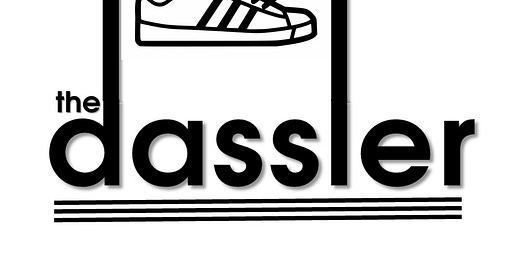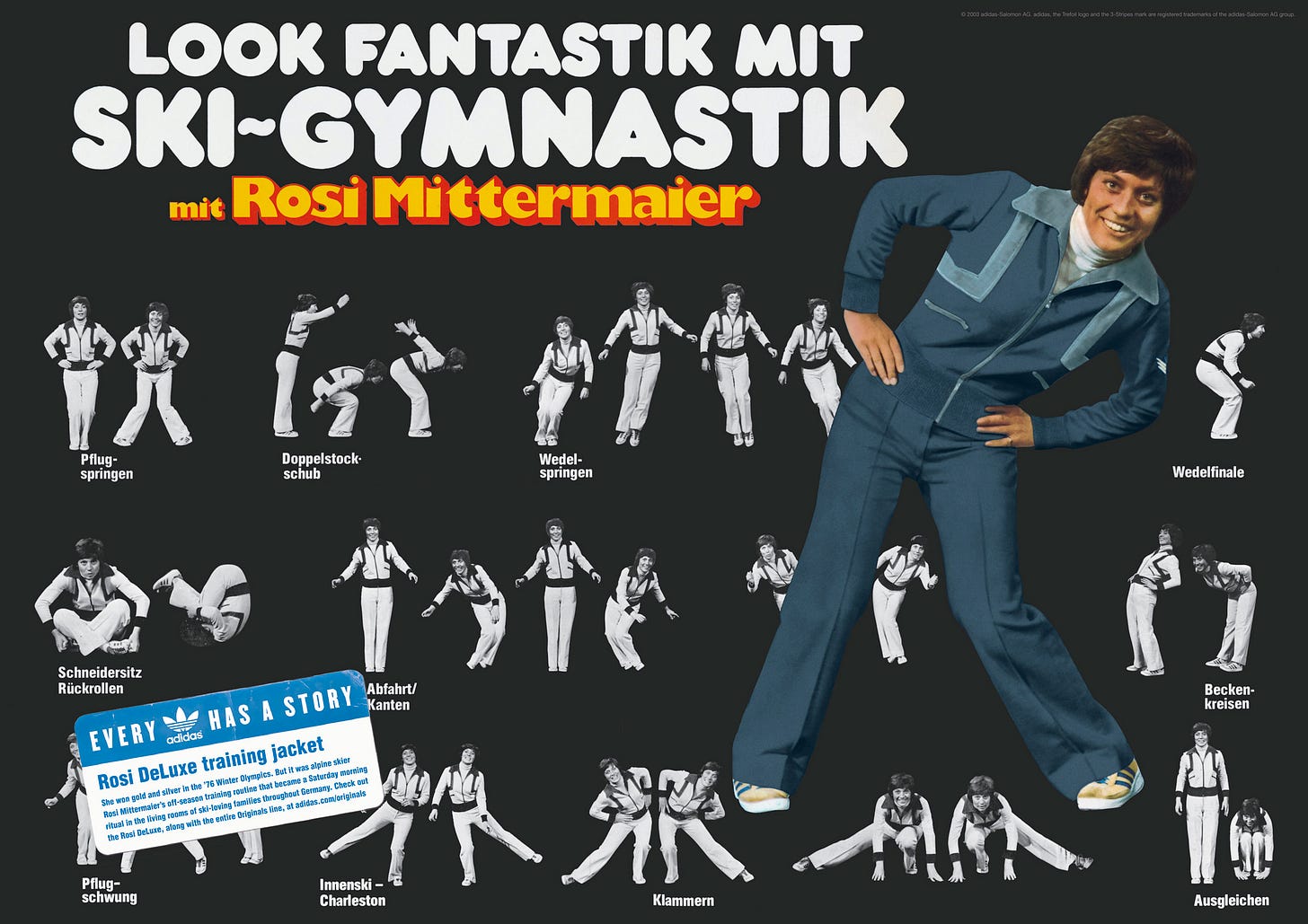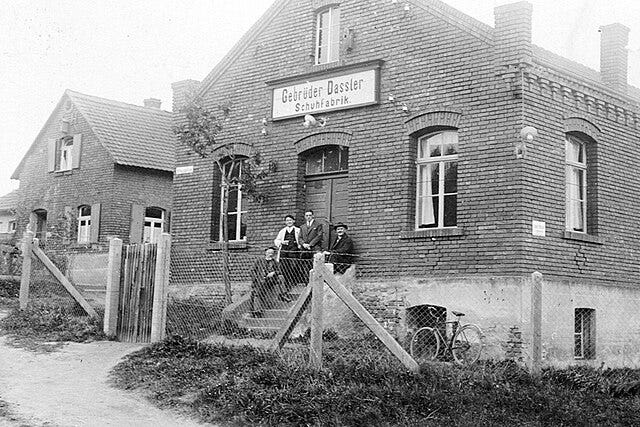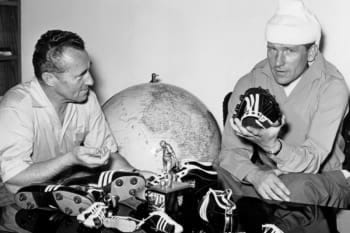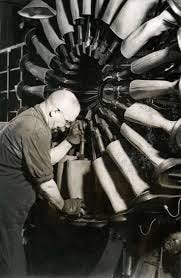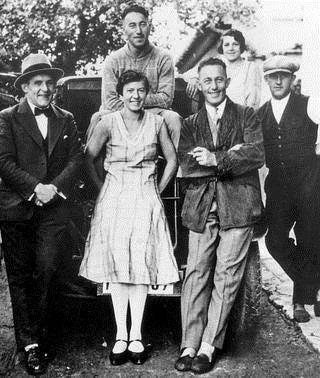The Dassler: Number 35- January 2025. Was Adi a Nazi? The story of the adidas Rom, Boost Sole Technology retro review & all the new releases.
Welcome to The Dassler, Thirty-Fifth edition. Read on for enough three stripe goodness to satisfy the most obsessive adidas fanatic.
Welcome to our first edition of The Dassler in 2025-number 35, the monthly magazine especially written for (and by) adidas lovers.
Thank you for continuing to subscribe to our little corner of adidas heaven.
The UK had Tiswas and Swap Shop-Germany had Rosi!
She won gold and silver in the '76 Winter Olympics. But it was alpine skier Rosi Mittermaier's off-season training routine that became a Saturday morning ritual in the living rooms of ski-loving families throughout Germany and inspired a generation of German skiers.
adidas re-released the Rosi DeLuxe training jacket in 2006.
adidas-always learning!
The Dassler usually comes out on the Third Saturday of each Month-to take your mind off spending all your money on adidas and give you something to do while waiting for the end of the months pay day!
In this edition in our ‘Retro shoe of the month’ we share the City Series OG -the adidas Rom-Part 1. Woody retro reviews the technology behind the adidas/BASF BOOST Sole, Craig shares another of his adidas adventures this time adidas EQT. We also have another adidas history lesson-this time we explore the early days of the Dassler brothers and Craig again reviews the latest adidas releases.
A massive three-striped thank you for subscribing, it takes a lot of hours to research, write, source and edit The Dassler and your support is very much appreciated.
If this is your first visit then we’d highly recommend you run over to the very beginning (obvs wearing a pair of OG colourway adidas ZX600’s)to our earlier issues here.
This is a monthly newsletter, that will contain ultra rare deadstock trainers, new adidas releases & brand exclusive information from 3 stripe social media giant Craig (@adifamily_ *X & Insta*), adidas oddments & apparel reminiscences written by Woody (@dadidassler *X* & Insta) plus loads of articles from special guest writers and we have some absolute adidas legends as guest writers lined up!
adidas History-was Adi really a Nazi?
There’s lots of stories behind the three stripe brand that we know and love but perhaps the one that has been swept under the carpet (literally no mention on the official adidas history page on their website)is an explanation about Adi’s (and Rudi’s) participation in the Second World War. Yes we’re well aware that not all publicity is good publicity and yes you don’t want to tell the whole world about your involvement with Adolf Hitler’s Nazi Party. Yet it still plays a part in the Dassler Story.
During World War II, industries big and small all over Germany became part of Hitler's massive war machine-no surprise happened in the UK-most factories converted into making things for the war effort. But you may be surprised to learn that the predecessors of footwear legendary brands Adidas and Puma, manufactured Germany's version of the bazooka!
Germany 1936 and Jesse Owens dug his spikes deep into the racing track of Berlin's Olympic Stadium, the best sprinter of his day dominating the 100 meters race to win a gold medal at the 1936 Olympic Games. America's black superstar took home a total of four gold medals. Each of his victories represented minor triumphs for two Germans-Adi (Adolf) and Rudi (Rudolf) Dassler the manufacturers of the sprinting shoes that carried the famous athlete from win to win.
The Dassler’s success did not come as a total surprise. Herzogenaurach, the brothers home town in Bavaria, had a long tradition as a centre for shoemaking. In 1922, it had a huge 112 shoemakers in a population of 3,500. In Herzo in 1924, Adolf and Rudolf Dassler founded the Gebruder Dassler Schuhfabrik or ‘Geda’ (Dassler Brothers Shoe Factory) to specialise in athletic shoes.
It’s not widely known but the brothers had previous Olympic success during the 1932 Olympic Games in Los Angeles, a German sprinter wearing Dassler spikes took the bronze medal. But it was the legendary shoes of Owens that established the Dasslers' worldwide reputation and laid the foundation for two exceptional careers.
You may be surprised to learn that the Dasslers both joined the Nazi Party in 1933, but just 3 years later gave Jessie Owens, a black american athlete, their spikes to wear at the Olympics. The Dassler brothers gave Owens tailor-made shoes all in white and with the two stripes that usually decorated the common Dassler shoes omitted from their special designed shoes.
Albert Speer, Hitler's chief architect stated that the Fuhrer was 'highly annoyed by the series of triumphs of the marvellous coloured American runner'.
'People whose antecedents came from the jungle...with stronger physiques... should be excluded from future games', he stated. Owens went on to become the sprinter of the century.
Even if you know little about Germany during this period, you may well understand why they joined the Nazi Party. Individuals and businesses were under enormous pressures to join, in fact Germans have a word ‘Gleichschaltung‘ which relates to the transformation of the whole country into a one party state (or dictatorship).
Fast forward to 1944 and there was suddenly a spike in the number of Allied tanks being blown apart by German fire. The culprit was the latest anti-tank rocket launcher, nicknamed the "Panzerschreck" (Tank Terror). This extremely effective weapon petrified Allied tank crews and believe it or not, was manufactured in the same factory that had developed Owens' shoes only eight years earlier.

This little-known excursion into the war industry by the two famous shoemakers was hardly an isolated case. Hitler's regime used many small and medium-sized companies to produce military equipment and armaments.
For the 'total war' proclaimed by Goebbels in early 1943, the Nazis needed a total war economy.
Lutz Budrass, a business historian at the University of Bochum.
Similar things were happening all across the country and German industry increasingly resembled one big military machine. The Hugo Boss textile factory, for example, in the southern German town of Metzingen, was also a military supplier. Beginning in late 1944, instead of suits and leather jackets, workers on the production floors of the future fashion legend were making ball bearings. Germany's flagship airline Lufthansa manufactured radar equipment for the Luftwaffe, Germany's air force, and furniture companies made parts for fighter jets.
Four years into World War II, not much Olympic glory was left among the shoemakers of Herzogenaurach. The German army was on the retreat on virtually all fronts, bombs were raining down on German cities and resources were running short. December 1943 marked the final blow for the town's shoe production. Hitler's regime ordered a halt to all civilian business operations, and the shoe-making machines in the Dassler Brothers' production hall were replaced with spot-welding equipment for making weapons. Before long, nearly everyone in Herzogenaurach was working for the military. The local lederhosen factory stopped making the traditional Bavarian leather shorts and, instead, started producing bread bags and rucksacks for soldiers. A nearby family business made torpedo parts for the navy.
Inside the Dassler Factory, shoe seamstresses, who had quickly been given makeshift training to work in the armaments industry, welded sights and blast shields onto the pipes. French forced labourers were also on the production line.
"The construction of the Panzerschreck was so simple that, given a little practice, even unskilled workers had hardly any problems manufacturing it,"
Dassler Factory worker.
But even with the simple design, German army inspectors still found themselves discarding many of the weapons made by Herzogenaurach's workers on account of their flaws.
With the war in full swing, many factory operations were hindered or shut down. Workers were hard to come by as people were being drafted for military service. Rudolf had become power hungry in the firm and was seeking to take control. He denied employment to his sister Marie’s sons so that no more family members would be involved in the company. As a result, both of Marie’s sons were drafted and killed during the war. Family tensions continued to grow as the wives of both Adi and Rudolf began to quarrel with one another.
As the war moved on, Adi was drafted in 1940 but was soon given leave as his presence in the Dassler Shoe Company was deemed necessary. Rudolf, who served in World War I, was drafted in 1943 and became enraged. He viewed his brother as responsible for having him sent off to war while Adi was able to control the business all by himself. Rudolf devised a plan to escape his post in Tuschin and return to the factory. He successfully made it back to Herzogenaurach but was eventually arrested by the Gestapo. He would spend the rest of the war boiling with anger in prison while Adi controlled the business. At the end of the war Rudolf was released, but his time in prison was not up.
The Americans had begun the denazification process of punishing those who belonged to the Nazi party. Rudolf was first arrested for the suspicions involving his relation to the secret service of the SS. He tried to plead his case, but his brother confirmed his relation and Rudolf’s testimony was disregarded. He remained in prison for another year while Adolf controlled the business and gained more power.
In 1946, Adi was classified as a belasteter (burden) by the denazification panel and was facing potential time in prison as well as removal from management in the shoe company. Rudolf saw this as his opportunity to seize power, so he devised statements claiming Adolf as a mastermind behind weapon production in the factory and that he was innocent and would have stopped him if he wasn’t in a prison camp. The panel did not listen to Rudolf, and Adi appealed the decision and was found not guilty placing him again as the head of the company over Rudolf.
The relationship of the Dassler brothers had slowly been deteriorating throughout the war, and now it had become almost unforgivable. Outraged with one another’s actions and the constant struggle to gain power, the Dassler brothers divided the company and all its assets and employees in 1948. The negotiations while separating the company would be the last time the Dassler brothers would ever speak to one another.
The dark chapter as a wartime weapons manufacturer was quickly forgotten at their successor companies, Adidas and Puma.
It’s very difficult to judge Adi for his involvement in the Nazi regime. Suffice to say that his greatest achievement as a Nazi Party member was to supply the shoes that a black American athlete won 4 gold medals with. Possibly the greatest irony is that Jessie Owens was largely ignored when he returned to a racially divided America and Adi went on to become possibly the greatest sports shoemaker of all time.
Although in the quiet community of Herzogenaurach, it was a legacy from the war that would be felt for many years to come and seen, in the pipes put to use all over town as gutters and fence posts rather than as the Panzerschrecks they had originally been meant for.
Keep reading with a 7-day free trial
Subscribe to The Dassler to keep reading this post and get 7 days of free access to the full post archives.


